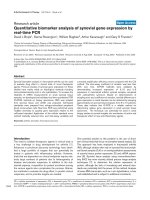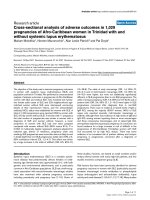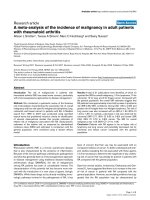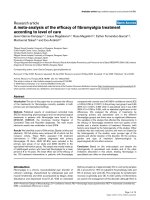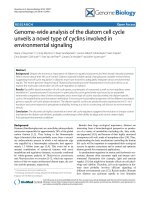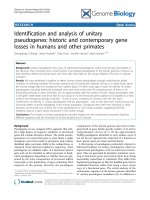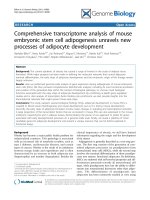Báo cáo y học: "Subunit-specific mutational analysis of residue N348 in HIV-1 reverse transcriptase." docx
Bạn đang xem bản rút gọn của tài liệu. Xem và tải ngay bản đầy đủ của tài liệu tại đây (1.08 MB, 9 trang )
RESEARCH Open Access
Subunit-specific mutational analysis of residue
N348 in HIV-1 reverse transcriptase
Jessica Radzio
1,2
and Nicolas Sluis-Cremer
1*
Abstract
Background: N348I in HIV-1 reverse transcriptase (RT) confers resistance to zidovudine (AZT) and nevirapine.
Biochemical studies demonstrated that N348I indirectly increases AZT resistance by decreasing the frequency of
secondary ribonuclease H (RNase H) cleavages that reduce the RNA/DNA duplex length of the template/primer
(T/P) and diminish the efficiency of AZT-monophosphate (MP) excision. By contrast, there is some discrepancy in
the literature in regard to the mechanisms associated with nevirapine resistance: one study suggested that it is due
to decreased inhibitor binding while others suggest that it may be related to the decreased RNase H cleavage
phenotype. From a structural perspective, N348 in both subunits of RT resides distal to the enzyme’s active sites, to
the T/P binding tract and to the nevirapine-b inding pocket. As such, the structural mechanisms associated with the
resistance phenotypes are not known.
Results: Using a novel modelled structure of RT in complex with an RNA/DNA T/P, we identified a putative
interaction between the b14-b15 loop in the p51 subunit of RT and the RNA template. Substitution of the
asparagine at codon 348 in the p51 subunit with either isoleucine or leucine abrogated the observed protein-RNA
interaction, thus, providing a possible explanation for the decreased RNase H phenotype. By contrast, alanine or
glutamine substitutions exerted no effect. To validate this model, we introduced the N348I, N348L, N348A and
N348Q mutations into RT and purified enzymes that contained subunit-specific mutations. N348I and N348L
significantly decreased the frequency of secondary RNase H cleavages and increased the enzyme’s ability to excise
AZT-MP. As predicted by the modelling, this phenotype was due to the mutation in the p51 subunit of RT. By
contrast, the N348A and N348Q RTs exhibited RNase H cleavage profiles and AZT-MP excision activities similar to
the wild-type enzyme. All N348 mutant RTs exhibited decreased nevirapine susceptibility, although the N348I and
N348L mutations conferred higher fold resistance value s compared to N348A and N348Q. Nevirapine resistance
was also largely due to the mutation present in the p51 subunit of RT.
Conclusions: This study demonstrates that N348I-mediated AZT and nevirapine resistance is due to the mutation
in the p51 subunit of RT.
Background
HIV-1 reverse transcriptase (RT) is a key target for antire-
troviral drug development. To date, 12 RT inhibitors
(RTIs) have been approved for the treatment of HIV-1
infection that can be classified into 2 distinct therapeutic
groups [1]. These include: (i) the nucleoside/nucleotide
RT inhibitors (NRTI) that b ind to the DNA polymerase
active site of the enzyme and act as competitive inhibitors
of DNA polymerization [2]; and (ii) the nonnucleoside
inhibitors (NNRTI) that bind to a non-active site pocket
in HIV-1 RT (termed the NNRTI-binding pocket) and act
as allosteric inhibitors of DNA polymerization [3].
Although combination therapies that contain two or more
RTI have profoundly reduced morbidity and mortality
from HIV-1 infection, their long-term efficacy is limited
by the selection of drug-resistant variants of HIV-1.
HIV-1 RT is a heterodimer composed of a 66 kDa sub-
unit (p66), and a p66-derived 51 kDa subunit (p51) [4].
The catalytically active p66 subunit of RT consists of
DNA polymerase, connection and ribonuclease H (RNase
H) domains. Most of the RTI resistance mutations identi-
fied to date map to the DNA polymerase domain of RT.
* Correspondence:
1
University of Pittsburgh School of Medicine, Department of Medicine,
Division of Infectious Diseases, Pittsburgh, PA 15261, USA
Full list of author information is available at the end of the article
Radzio and Sluis-Cremer Retrovirology 2011, 8:69
/>© 2011 Radzio and Sluis-C remer; licensee BioMed Central Ltd. This is an Open Access article distributed under the terms of the Creat ive
Commons Attribution License ( which permits unrestrict ed use, distribution, and
reprodu ction in any medium, provided the origi nal work is properly cited.
However, a growing body of evidence has emerged that
implicates mutations outside of the polymerase domain
of RT in RTI resistance [5]. In this regard, the N348I
mutation in the connect ion domain of HIV-1 RT has
received significant attention in the last 4 years. This
mutation can be selected relatively early during vi rologic
failure and confers resistance to both zidovudine (AZT)
and nevirapine [6]. Furthermore, N348I can compensate
for the antagonism of thymidine analog mutations
(TAMs) by the L74V, Y181C or M184V mutations [7].
Previous biochemical studies demonstrated that N348I in
HIV-1 RT indirectly increases AZT resistance by
decreasing the frequency of secondary ribonuclease H
(RNase H) cleavages that significantly reduce the RNA/
DNA duplex length of the template/primer (T/P) and
diminish the efficiency of AZT-monophosphate (MP)
excision [6,8]. By contrast, there is some discrepancy in
the literature in regard to the mechanisms associated
with nevirapine resistance: one study has suggested it is
due to decreased inhibitor binding [9], while other stu-
dies suggest that it may also be due t o the decreased
RNase H cleavage phenotype of the N348I HIV-1 RT
[10,11]. Interestingly, in the available crystal structures of
HIV-1 RT, residue N348 in both subunits of the enzyme
is located distal to the DNA polymerase and RNase H
active sites, to the T/P substrate, to residues that com-
prise the nucleic acid binding tract and to the NNRTI-
binding pocket [Figure 1A, B]. Therefore, it is not evident
how N348I in HIV-1 RT impacts the RNase H cleavage
of the enzyme or decreases drug susceptibility. In this
study, we used a combination of molecular modelling
and biochemical analyses to address this question.
Results and Discussion
Molecular models of wild type (WT) and N348 mutant
HIV-1 RT in complex with an RNA/DNA T/P
In the crystal structure of HIV-1 RT in complex with a
polypurine tract RNA/DNA hybrid [12], residue N348 in
both subunits is not proximal to the enzyme’ sactive
sites, to the RNA/DNA T/P substrate, to residues that
comprise the nucleic acid binding tract and to the
NNRTI-binding pocket [Figure 1A, B]. Accordingly, the
mechanisms by which N348I decreases RT RNase H
activity and drug susceptibility cannot be inferred from
this structure. It should, however, be noted that although
the RNA/DNA duplex extends into the RNase H domain
of RT in this structure, it miss es the active site by ~ 4 Å.
Recently, a crystal structure of the human RNase H1 was
solved in complex with an RNA/DNA substrate which
extends directly into the enzyme’ s active site [13].
Because of the similarity between the human RNase H1
and the RNase H domains of HIV-1 RT, t he authors
were able to model an RNA/DNA dupl ex into HIV-1 RT
that extends from the RNase H active site of the enzyme.
It should be noted that due to the orientation and con-
formation of the bound T/P in thi s model, HIV-1 RT
cannot simultaneously carry-out DNA polymerization
and RNase H cleavage. Accordingly, it was proposed that
the R NA/DNA T/P substrate would need to toggle
between both active sites [13]. A recent study by Beil-
hartz et al., however, refutes this hypothesis [14]. Never-
theless, in this model, residues Y342, P345 and F346
from the b14-b15 loop of the p51 subunit of HIV-1 RT
directly interact with the RNA template backbone [Figure
1C]. The C
b
atom of N348 forms a network of interac-
tions with the C
b
atom and backbone atoms of Y342.
[N348 in p66 remains distal to the RNA/DNA substrate
in this model (data not shown)]. When the N348I muta-
tion is introduced into the p51 subunit i n this str ucture
by molecular modelling (Figure 1D), the p osition of the
b14-b15 loo p is shifted s uch that P345 and F346 no
longer contact the RNA template. The repositioning o f
this loop in the N348I RT is likely due to the bulky s ide-
chain of isoleucine disrupting the network of interactions
between this residue and Y342. Similarly, the introduc-
tion of leucine (Figure 1F) or glutamic acid (data not
shown) at residue 348 in the p51 subunit of RT resulted
in a s hift of the b14-b15 loop away from the RNA tem-
plate. By contrast, introduction of alanine (Figure 1E) or
glutamine (data not shown) had little impact on the posi-
tion of this loop. Both these substitutions retain the criti-
cal network of interactions between residue 348 and 342.
Interestingly, the introduction of a n arginine residue
appeared to enhance the interactions of the P345 and
F346 with the RNA template (data not shown). Taken
together, these modelling studies suggest that the N348I
mutation in the context of the p51 subunit of HIV-1 RT
maydecreasetheenzyme’ s RNase H activity via an
altered interaction with the RNA template. Importantly,
these modelling analyses provided a testable hypothesis.
Subunit-specific mutational analysis of residue N348 in
HIV-1 RT
As described above, our modelling data suggested that
theRNaseHactivityofHIV-1RTcouldbemodulated
by mutations at residue N348 in the p51 subunit of the
enzyme. Accordingly, we ge nerated by site directed
mutagenesis six HIV-1 RT constructs that contained the
N348I, N348A, N348Q, N348L, N348E or N348R muta-
tions. Initially, enzymes that harbored the mutations in
both subunits were purified to ho mogeneity and
assessed for RNA-dependent DNA polymerase activity
(Figure 2 A). The DNA polymerase activities of N348A,
N348I, N348L and N348Q were found to be similar to
that of the WT enzyme. By contrast, the polymerase
activities of t he N348E and N348R RTs were decreased
significantly compared to the WT enzyme, and accord-
inglytheywereexcludedfromsubsequentanalyses.
Radzio and Sluis-Cremer Retrovirology 2011, 8:69
/>Page 2 of 9
Next, we over-expressed and purified RTs that con-
tained subunit-specific mutations using the pDUET
expression vector (see Methods). In this regard, we suc-
cessfully purified the p66
N348I
/p51
WT
,p66
N348A
/p51
WT
,
p66
N348Q
/p51
WT
and p66
WT
/p51
N348L
enzymes. Impor-
tantly, the DNA polymerase activities of these purified
enzymes were similar to that of the WT enzyme purified
under the same conditions (Figure 2B). Unfortunately,
we were unable to purify several other subunit-specific
combinations due to low expression levels, protein inso-
lubility, or inability of the p66 and p51 subunits to form
functional RT heterodimers. To determine whether an
348
346
345
342
348
346
345
342
348
346
345
342
348
346
345
342
348
(p51) 348
(p66)
348
(p51) 348
(p66)
348
346
345
342
348
346
345
342
A
B C
D
E
F
> 7 Å
348
348
348
345
345
345
346
346
346
Figure 1 Interaction between residue N348 in the p51 subunit of HIV-1 RT and t he RNA template. A) Crystal structure of HIV-1 RT in
complex with a polypurine tract RNA/DNA T/P (pdb accession code 1HYS). The p66 DNA polymerase, connection and RNase H domains are
colored cyan, green and yellow, respectively. The p51 subunit is colored orange. The DNA and RNA strands are colored white and purple,
respectively. Residues in the connection and RNase H domain that form part of the nucleic acid binding tract are shown in spacefill (and
colored according to domain color). B) Location of the b14-b15 loop in the p51 subunit of HIV-1 RT in complex with a PPT RNA/DNA hybrid.
Residues 345 and 346 reside > 7Å from the RNA strand. C) Location of the b14-b15 in the p51 subunit of HIV-1 RT in complex with an RNA/
DNA duplex that extends into the RNase H active site. Residues 345 and 346 all directly contact the RNA template. The co-ordinates for the
model were kindly provided by Dr M. Nowotny. D, E, F) Impact of the N348I (D), N348A (E) and N348L (F) mutations on the b14-b15 loop in the
p51 subunit of HIV-1 RT in complex with an RNA/DNA duplex that extends into the RNase H active site. The WT and mutant structures are
colored green and pink, respectively. The co-ordinates for this structure were kindly provided by Dr M. Nowotny (NIDDK, NIH). Mutations were
introduced into this structure using MOE. Charges were calculated using the Gasteiger method, and iterative minimizations were carried out
using the AMBER 99 force field until the energy difference between iterations was less than 0.0001 kcal/mol per Å.
Radzio and Sluis-Cremer Retrovirology 2011, 8:69
/>Page 3 of 9
alternate purification strategy would be via ble, we also
expressed the p66 and p51 subunits separately (see Meth-
ods). The bacterial lysates were then mixed and HIV-1
RT purified using a dual tag strategy that involved nickel-
and FLAG-affinity chromatography. This alternate
approach, however, was also unsuccessful. Previously
Schuckman et al. described the purification of p66
WT
/
p51
N348I
HIV-1 RT [9]. In this regard, it is important to
note that their approach involved nickel affinity and
mono Q anion exchange chromatography, and not the
dual tag affinity strategy used in our study. Because the
p66 subunit of RT can be cleaved to p51 by bacterial pro-
teases, one cannot exclude the possibility that the puri-
fied enzymes prepared by Schuckman and co-workers
were not contaminated by p66
N348I
/p51
N348I
HIV-1 RT.
ATP mediated excision of AZT-MP from a chain-
terminated T/P by WT and N348 mutant HIV-1 RT
TAMs in HIV-1 RT confer AZT resistance by enabling
theenzymetoexcisethechain-terminatingAZT-MP
moiety from the 3’-end of the DNA primer using ATP
as a phosphate donor [15]. Previous biochemical studies
demonstrated that N348I in HIV-1 RT indirectly
increases AZT resistance by decreasi ng the frequency of
secondary RNase H cleavages that significantly reduce
the RNA/DNA duplex length of the T/P and diminish
the efficiency of AZT-MP excision [6,8]. As such, we
first assessed the AZT-MP excision activity of the WT
and N348 mutant enzymes on a well-defined RNA/
DNA T/P substrate that is routinely used in our labora-
tory [6,7,16,17]. When the mutation at residue 348 was
present in both the p66 and the p51 subunits of RT,
only the N®IandN®L substitutions conferred an
enhanced ability to excise AZT-MP compared to the
WT enzyme (Figure 3A). However, when N348I was
present only in the p66 subunit, the mutant enzyme
exhibited AZT-MP excision activity that was simi lar to
the WT RT (Figure 3B). By contrast, when N348L wa s
present in the p51 subunit only, the mutant enzyme
exhibited robust AZT-MP excision activity (Figure 3B).
As predicted by the molecular modelling studies, the
N348A and N348Q mutations had minimal impact on
the ATP-mediated excision activity of the enzyme (Fig-
ures 3A, B). As expected, the mutant RTs exhibited
ATP-mediated excision activities on a DNA/DNA T/P
substrate that were comparable to the WT enzyme (Fig-
ure3C).Wepreviouslydelineatedtherelationship
between AZT-MP excision efficiency and RNase H
activity on the RNA/DNA T/P substrate used in these
experiments [16,17]. These studies showed that the pri-
mary polymerase-dependent RNase H cleavage of RT
does not impact the enzyme’ sAZT-MPexcision
RT
A
ct
i
v
i
ty
(Relative to WT)
0
20
40
60
80
100
RT Activity
(Relative to WT)
0
20
40
60
80
100
120
140
*
*
A B
Figure 2 DNA polymerase activity of recombinant purified HIV-1 RT that contained mutations at residue N348 in both subunits (A), or
in only one subunit (B), of the enzyme. The DNA polymerase activity was assessed as described in the Methods. Data are reported as an
average ± standard deviation of at least 3 separate experiments. An asterisk indicates P < 0.01 compared with WT (Student’s t-test).
Radzio and Sluis-Cremer Retrovirology 2011, 8:69
/>Page 4 of 9
efficiency, but polymerase-independent RNase H clea-
vages that reduce the RNA/DNA duplex length to less
than 12 nucleotides abolish AZT-MP excision activity.
In light of these data, we next evaluated the RNase H
activity of WT and N348 mutant RT that occurred dur-
ing the ATP-mediated excision reactions described in
Figure 3. As reported previously [6,8], N348I signifi-
cantly reduced the frequency of a polymerase-indepen-
dent cleavage event that decreases the RNA/DNA
duplex to 10 nucleotides (Figure 4B). Consistent with
the observed increase i n AZT-MP excision activity, the
N348L mutation also significantly decreased the fre-
quency of this polymerase-independent cleavage event.
By contrast, the N348A and N348Q enzymes retained
near WT-like RNase H cleavage activities. Inte restin gly ,
when the N348I mutation wa spresentonlyinthep66
subunit, the observed RNase H cleavage pattern was
similar to that of the WT enzyme (Figure 4C). By
Time (min)
0 30 60 90 120
AZT-MP Excised (Relative to WT)
0.0
0.3
0.6
0.9
1.2
1.5
1.8
WT HIV-1 RT
N348I HIV-1 RT
N348A HIV-1 RT
N348Q HIV-1 RT
N348L HIV-1 RT
Time (min)
0 20 40 60 80 100 120
AZT-MP Excised (Relative to WT)
0.0
0.5
1.0
1.5
2.0
2.5
3.0
p66
WT
/p51
WT
p66
N348I
/p51
WT
p66
N348A
/p51
WT
p66
N348Q
/p51
WT
p66
WT
/p51
N348L
Time
(
min
)
0 20 40 60 80 100 120
AZT-MP Excised (Relative to WT)
0.0
0.2
0.4
0.6
0.8
1.0
1.2
WT HIV-1 RT
N348I HIV-1 RT
N348A HIV-1 RT
N348Q HIV-1 RT
N348L HIV-1 RT
A B
C
Figure 3 AZT-MP excision activity of HIV-1 RT containing mutations at residue 348. A) Time course of ATP-mediated AZT-MP excision
reactions carried out by HIV-1 RT containing mutations at residue N348 in both subunits of the enzyme on an RNA/DNA T/P. Data are the mean
± standard deviation from at least three independent experiments. B) Time course of ATP-mediated AZT-MP excision reactions carried out by
HIV-1 RT containing mutations at residue N348 in only one subunit of the enzyme on an RNA/DNA T/P. Data are the mean ± standard deviation
from at least three independent experiments. C) Time course of ATP-mediated AZT-MP excision reactions carried out by HIV-1 RT containing
mutations at residue N348 in both subunits of the enzyme on a DNA/DNA T/P. Data are the average from at least two independent
experiments.
Radzio and Sluis-Cremer Retrovirology 2011, 8:69
/>Page 5 of 9
contrast, when N348L was present only in the p51 subu-
nit, the mutant enzyme showed an RNase H phenotype
similar to the enzyme that contained the N348L muta-
tion in both subunits (Figure 4B, C). Taken together,
these data show that t he N348I or N348L mutations in
thep51subunitofHIV-1RTareresponsibleforthe
observed decreased RNase H c leavage and increased
AZT-MP excision phenotypes. This finding is consistent
with that of Schuckmann et al. who also reported that
the N348I mutant in the p51 subunit conferred the
WT
N348I
N348A
N348Q
N348L
Time
(0-90 min)
Time
(0-90 min)
Time
(0-90 min)
Time
(0-90 min)
Time
(0-90 min)
No RT
Time
(
0-90 min
)
Time
(
0-90 min
)
Time
(
0-90 min
)
Time
(
0-90 min
)
Time
(
0-90 min
)
p66
WT
/
p51
WT
No RT
p66
N348I
/
p51
WT
p66
N348A
/
p51
WT
p66
N348Q
/
p51
WT
p66
WT
/
p51
N348L
A
B
C
25
18
15
1
0
25
18
15
1
0
Figure 4 RNase H cleavage activity of recombinant purified HIV-1 RT that contained mutations at residue N348. A) Schematic illustrating the
location of the RNase H cleavage sites in the RNA template. B) Autoradiogram of the RNase H cleavage patterns of HIV-1 RTs containing mutations at
residue 348 in both subunits of the enzyme. Experiments were carried out as described in the Methods. The reaction times were 1, 3, 5, 10, 20, 30, 45,
60 and 90 min. C) Autoradiogram of the RNase H cleavage patterns of HIV-1 RTs containing mutations at residue 348 in either the p66 or p51 subunits
of the enzyme. Experiments were carried out as described in the Methods. The reaction times were 1, 3, 5, 10, 20, 30, 45, 60 and 90 min.
Radzio and Sluis-Cremer Retrovirology 2011, 8:69
/>Page 6 of 9
decreased RNase H/increased AZT-MP excision pheno-
type [9].
Susceptibility of WT and N348 mutant HIV-1 RT to
nevirapine
Next, we determined the susceptibility of the WT and
N348 mutant HIV-1 RT to nevirapine (Table 1). Our
results show that t he N348A, N348I, N348Q and N348L
mutations confer nevirapine resistance when present in
both the p66 and p51 subunits of HIV-1 RT. However, it
should be noted that HIV-1 RTs that contained the
N348I and N348L mu tations showed fold-changes in
nevirapine resistance (8.6- and 11.4-fold, respectively)
that were greater than those calculated for the N348A
(3.4-fold) or N348Q (2.4-fold) HIV-1 RTs. Interestingly,
when the N348A, N348Q or N348I mutations were pre-
sent in the p66 subunit only, RT susceptibility to nevira-
pine was similar to that of the WT enzyme (Table 1). By
contrast, when N348L was present in p51 only, HIV-1
RT exhibited 5.7-fold nevirapine resistance. Taken
together, these data strongly suggest that nevirapine
resistance, like AZT resistance, is also due to the muta-
tion in the p51 subunit of RT. It should be noted, how-
ever, that the fold-change in nevirapine resistance was
lower for the p66
WT
/p51
N348L
RT (5.7-fold) compared to
p66
N348L
/p51
N348L
RT (11.4-fold). As such, the mutation
in the p66 subunit may augment nevirapine resistance.
Nikolenko et al. proposed that the decrease in RNase H
activity due to mutations in the connection or RNase H
domains of HIV-1 RT preserves the RNA template and
provides more time for NNRTIs to dissociate from the
RT, resulting in the resumption of DNA synthesis and
enhanced NNRTI resistance [11]. Of note, our data show
that the two mutations t hat have a significant impact on
the RNase H phenotype (i.e. N348I and N348L) also con-
fer the highest levels of n evirapine resistance, thus pro-
viding additional support for a link between RNase H
cleavage and NNRTI resistance. However, the N348A
and N348Q mutat ions also yielded nevirapine resistance.
Since these mu tations do not significan tly impact the
RNase H phenotype, one must conclude that they confer
resista nce via an RNase H independent phenotype. Inter-
estingly, previous studies have demonstrated that N348I
confers nevirapine resistance on both RNA/DNA and
DNA /DNA T/P substrates [9,10], suggesting that factors
in additi on to RNase H cleavage impact nevirapine bind-
ing. Recently, Schuckmann et al. reported that the N348I
mutation in either subunit caused ne virapine resistance
[9]. Specifically, they showed that the mutation in p66
alone caused nevirapine resistance without significantly
affecting RNase H activity, whereas the mutation in p5 1
caused nevirapine resistance and impaired RNase H
activity. The nevirapine fold-resistance va lues (~ 2-3
fold) determined by Schuckmann et al. were signifi cantl y
less than the values determined in our study. Further-
more, they reported approximately ~ 2-2.7 -fold resis-
tance when the N348I mutation was present in both
subunits; ~ 1.9-2-fold when present in p66 only; and 2. 7-
3.1-fold when present in p51 only (see Table three in
[9]). If nevirapine resistance was due to the mutation in
both subunits, one wou ld expect a higher fold -resistance
for the p66
N348I
/p51
N348I
RT compared to the p66
N348I
/
p51
WT
or p66
WT
/p51
N348I
enzymes. As mentioned pre-
viously, the purification strategy used by Schuckmann et
al. did not employ an affinity chromatography step that
was specific for each subunit. As such, their enzyme pre-
parations may have been contaminated by p66
N348I
/
p51
N348I
RT generated by bacterial proteases, thus com-
plicating data analysis.
Conclusions
This study demonstrates that N348I-mediated AZT and
nevirapine resistance is likel y due to the mutation in the
p51 sub unit of RT . It should be noted, ho wever, that the
interpretation of our data is limited by our inability to pur-
ify and characterize p66
WT
/p51
N348I
HIV-1 RT. The mole-
cular modelling suggests that the N348I mutation
abrogates an interaction between the b14-b15 loop in the
p51 subunit of RT and the RNA template, which may
explain the observed decrease in the secondary or poly-
merase independent RNase H cleavages. Nevirapine resis-
tance appears complex and may involve both RNase
H-dependent and -independent mechanisms.
Methods
Molecular modelling
The co-ordinates for the molecular model of HIV-1 RT
in complex with an RNA/DNA duplex that extends into
theRNaseHactivesiteoftheenzyme[13]werekindly
provided by Dr. Marcin Nowotny. To generate the mod-
els, we first selected the N348 residue in the p51 subu-
nit and selected all amino acid residues within a 20 Å
radius. These residues were then subjected to energy
Table 1 Susceptibility of WT and N348 mutant HIV-1 to
nevirapine
Enzyme IC
50
(μM) Fold Resistance
p66
WT
/p51
WT
0.52 ± 0.04 -
p66
N348A
/p51
N348A
1.77 ± 0.50 3.4
p66
N348A
/p51
WT
0.62 ± 0.07 1.2
p66
N348I
/p51
N348I
4.60 ± 0.45 8.6
p66
N348I
/p51
WT
0.50 ± 0.11 0.97
p66
N348L
/p51
N348L
5.93 ± 0.54 11.4
p66
WT
/p51
N348L
2.96 ± 0.10 5.7
p66
N348Q
/p51
N348Q
1.25 ± 0.13 2.4
p66
N348Q
/p51
WT
0.36 ± 0.05 0.7
Radzio and Sluis-Cremer Retrovirology 2011, 8:69
/>Page 7 of 9
minimization using the Molecular Operating Environ-
ment (Chemical Computing Group, Mo ntreal, Quebec,
Canada). The rest of RT and the RNA/DNA T/P sub-
strate were frozen and were not subjected to energy
minimiz ation. Charges were calculated using the Gastei-
ger method, and iterative minimizations were carried
out using the AMBER 99 forcefield until the energy dif-
ference between iterations was less than 0.0001 kcal/mol
per Å. These initial minimization experiments had mini-
mal effect on the o verall structure of the RT. Next, we
introduced the N348I/A/Q/E/R/L mutations into the
p51 subunit of HIV-1 RT, and carried out energy mini-
mizations as described above. Modeled RT structures
were visualized using MOE or the UCSF Chimer a pack-
age from the Resource for Biocomputing, Visualization,
and Informatics at the University of California, San
Francisco (supported by NIH P41 RR001081).
Reagents
AZT- TP was purchased from Sierra Bioresearch (Tuscon,
AZ). Nevirapine was obtained from the NIH AIDS
Research and Reference Reagent Program. ATP, dNTPs,
and ddNTPs were purchased from GE Healthcare (Piscat-
away, NJ), and [g-
32
P]ATP was acquired from PerkinElmer
Life Sciences (Boston, MA). RNA and DNA oligonucleo-
tides were synthesized by Integrated DNA Technologies
(Coralville, IA).
Site-directed mutagenesis and protein expression
The N348A, N348E, N348L, N348Q and N348R muta-
tions were introduced into the wild-type (WT) p6HRT-
Prot prokaryotic expression vector [18] by s ite-directed
mutagenesis using the QuikChange mutagenesis kit
(Stratagene La Jolla, CA). F ull-length sequencing of
mutant RTs was performed to confirm the presence of
the desired mutations and to exclude adventitious muta-
tions introduced during mutagen esis. The mutant HIV-1
RTs were purified as described previously [18]. For subu-
nit selective mutagenesis, the p66 and p51 RT genes were
cloned into the pET-DUET vector (Novagen-EMD Bios-
ciences Inc., San Diego, California). The p66 subunit was
expressed as an N-terminal hexahistidine fusion protein
whereasp51wasexpressedasanN-terminalFLAG
fusion protein. The p66 and p51 subunits of RT were
also cloned into the pBAD/His B (Invitrogen) and pT7-
FLAG (Sigma) expression vectors to generate His-p66
and FLAG-p51, respectively. Enzymes were expressed
and purified as described previously using a double-tag
strategy [19]. The protein concentration of the purified
enzymes was determined spectrophoto metrically at
280 nm using an extinction coefficient (ε
280
) of 260450
M
-1
cm
-1
, and by Bradford protein assays (Sigma-Aldrich,
St. Louis, MO).
AZT-MP excision assays
A 26-nucleotide DNA primer (pr26;5’-CCTGTTCGGG
CGCCACTGCTAGAGAT-3’)was5’-radiolabeled with
[g-
32
P]ATP and chain-terminated with AZT-MP to gener-
ate P
AZT
as reported previously [6,7,16,17]. P
AZT
was then
annealed to a 35-nucleotide RNA template (T
RNA
:5’-
AGAAUGGAAAAUCUCUAGCAGUGGCGCCCG
AACAG-3’). ATP-mediated AZT-MP excision assays were
carried out by first incubating 20 nM T
RNA
/P
AZT
with
3mMATP,10mMMgCl
2
,1μM dTTP and 10 μM
ddCTP in a buffer containing 50 mM Tris-HCl (pH 7.5)
and 50 mM KCl. Reactions were initiated by the addition
of 200 nM WT or mutant RT. Aliquots were removed at
defined times, quenched with sample loading buffer (98%
deionized formamide, 1 mg/ml each of bromophenol blue
and xylene cyanol), denatured at 95°C for 8 min, and then
product was resolved from substrate by denaturing polya-
cylamide gel electrophoresis and analyzed, as reported pre-
viously [6,7,16,17].
Assay for RT RNase H activity
WT and mutant RT RNase H activity was evaluated
using the same AZT-MP chain-terminated RNA/DNA
T/P substrate described above, except the 5’-end of the
RNA was
32
P-end-labelled. Assays were carried out using
20 nM T
RNA
/P
AZT
,3mMATPand10mMMgCl
2
in a
buffer containing 50 mM Tris-HCl (pH 7.5) and 50 mM
KCl. Reactions were initiated by the addition of 200 nM
WT or mutant HIV-1 RT. Aliquots were removed,
quenched at varying times, and analyzed as describe d
above.
Inhibition of WT and N348 mutant HIV-1 RT by nevirapine
Fixed time point assays using a heteropolymeric T/P sub-
strate were used to determine HIV-1 RT DNA polymerase
activity, as reported previously [20]. The sequence of the
DNA primer and RNA template were 5’-TCGGGCGCC
ACTGCTAGAGA-3’ and 5’-UCAGACCCUUUUAGU-
CAGAAUGGAAAGUCUCUAGCAGUGG CGCCCGAA-
CAGGGACA-3’, respectively. The primer was synthesized
with a biotin label on their 5’-terminus. DNA polymerase
reactions using heteropolymeric T/P (600 nM) were car-
ried out in 50 mM Tris-HCl pH 7.5 (37°C), 50 mM KCl,
10 mM MgClB
2B
containing 600 nM T/P, 10 μM of each
[P
3P
H]dNTP, and variable concentrations of ne virapine
(0-20 μ M). Reactions were initiated by the addition of
25 nM of RT, incubated for 20 min at 37°C and then
quenched with 0.5 M EDTA. Streptavidin Scintillation
Proximity Assay beads (GE Healthcare, Piscataway, NJ)
were then added to each reaction, and the extent of radio-
nucleotide incorporation was determined by scintillation
spectrometry using a 1450 Microbeta Liquid Scintillation
Counter (Perkin Elmer, Waltham, MA).
Radzio and Sluis-Cremer Retrovirology 2011, 8:69
/>Page 8 of 9
Acknowledgements
This study was supported by a grant (R01 AI081571) from the National
Institute of Health Allergy and Infectious Diseases, National Institutes of
Health to N.S C. J.R. was supported by a fellowship from the Pitt Aids
Research Training (PART) grant (T32 AI065380).
Author details
1
University of Pittsburgh School of Medicine, Department of Medicine,
Division of Infectious Diseases, Pittsburgh, PA 15261, USA.
2
University of
Pittsburgh Graduate School of Public Health, Department of Infectious
Diseases and Microbiology, Pittsburgh, PA 15261, USA.
Authors’ contributions
Conceived and designed the experiments: JR and NSC. Performed the
experiments: JR. Analyzed the data: JR and NSC. Wrote the paper: NSC. All
authors read and approved the final manuscript.
Competing interests
The authors declare that they have no competing interests.
Received: 11 April 2011 Accepted: 22 August 2011
Published: 22 August 2011
References
1. De Clercq E: Antiretroviral drugs. Curr Opin Pharmacol 2010, 10:507-515.
2. Goody RS, Müller B, Restle T: Factors contributing to the inhibition of HIV
reverse transcriptase by chain-terminating nucleotides in vitro and in
vivo. FEBS Lett 1991, 291:1-5.
3. Kohlstaedt LA, Wang J, Friedman JM, Rice PA, Steitz TA: Crystal structure at
3.5 A resolution of HIV-1 reverse transcriptase complexed with an
inhibitor. Science 1992, 256:1783-1790.
4. di Marzo Veronese F, Copeland TD, DeVico AL, Rahman R, Oroszlan S,
Gallo RC, Sarngadharan MG: Characterization of highly immunogenic p66/
p51 as the reverse transcriptase of HTLV-III/LAV. Science 1986,
231:1289-1291.
5. Ehteshami M, Götte M: Effects of mutations in the connection and RNase
H domains of HIV-1 reverse transcriptase on drug susceptibility. AIDS Rev
2008, 10:224-235.
6. Yap SH, Sheen CW, Fahey J, Zanin M, Tyssen D, Lima VD, Wynhoven B,
Kuiper M, Sluis-Cremer N, Harrigan PR, Tachedjian G: N348I in the
connection domain of HIV-1 reverse transcriptase confers zidovudine
and nevirapine resistance. PLoS Med 2007, 4:e335.
7. Radzio J, Yap SH, Tachedjian G, Sluis-Cremer N: N348I in reverse
transcriptase provides a genetic pathway for HIV-1 to select thymidine
analogue mutations and mutations antagonistic to thymidine analogue
mutations. AIDS 2010, 24:659-667.
8. Ehteshami M, Beilhartz GL, Scarth BJ, Tchesnokov EP, McCormick S,
Wynhoven B, Harrigan PR, Götte M: Connection domain mutations N348I
and A360V in HIV-1 reverse transcriptase enhance resistance to 3’-azido-
3’-deoxythymidine through both RNase H-dependent and -independent
mechanisms. J Biol Chem 2008, 283:22222-22232.
9. Schuckmann MM, Marchand B, Hachiya A, Kodama EN, Kirby KA, Singh K,
Sarafianos SG: The N348I mutation at the connection subdomain of HIV-
1 reverse transcriptase decreases binding to nevirapine. J Biol Chem
2010, 285:38700-38709.
10. Biondi MJ, Beilhartz GL, McCormick S, Götte M: N348I in HIV-1 reverse
transcriptase can counteract the nevirapine-mediated bias toward RNase
H cleavage during plus-strand initiation. J Biol Chem 2010,
285:26966-26975.
11. Nikolenko GN, Delviks-Frankenberry KA, Pathak VK: A novel molecular
mechanism of dual resistance to nucleoside and nonnucleoside reverse
transcriptase inhibitors. J Virol 2010, 84:5238-5249.
12. Sarafianos SG, Das K, Tantillo C, Clark AD Jr, Ding J, Whitcomb JM, Boyer PL,
Hughes SH, Arnold E: Crystal structure of HIV-1 reverse transcriptase in
complex with a polypurine tract RNA:DNA. EMBO J 2001, 20:1449-1461.
13. Nowotny M, Gaidamakov SA, Ghirlando R, Cerritelli SM, Crouch RJ, Yang W:
Structure of human RNase H1 complexed with an RNA/DNA hybrid:
insight into HIV reverse transcription. Mol Cell 2007,
28:264-276.
14. Beilhartz GL, Wendeler M, Baichoo N, Rausch J, Le Grice S, Götte M: HIV-1
reverse transcriptase can simultaneously engage its DNA/RNA substrate
at both DNA polymerase and RNase H active sites: implications for
RNase H inhibition. J Mol Biol 2009, 388:462-474.
15. Meyer PR, Matsuura SE, Mian AM, So AG, Scott WA: A mechanism of AZT
resistance: an increase in nucleotide-dependent primer unblocking by
mutant HIV-1 reverse transcriptase. Mol Cell 1999, 4:35-43.
16. Radzio J, Sluis-Cremer N: Efavirenz accelerates HIV-1 reverse transcriptase
ribonuclease H cleavage, leading to diminished zidovudine excision. Mol
Pharmacol 2008, 73:601-606.
17. Brehm JH, Mellors JW, Sluis-Cremer N: Mechanism by which a glutamine
to leucine substitution at residue 509 in the ribonuclease H domain of
HIV-1 reverse transcriptase confers zidovudine resistance. Biochemistry
2008, 47:14020-14027.
18. Le Grice SF, Grüninger-Leitch F: Rapid purification of homodimer and
heterodimer HIV-1 reverse transcriptase by metal chelate affinity
chromatography. Eur J Biochem 1990, 187:307-314.
19. Nissley DV, Radzio J, Ambrose Z, Sheen CW, Hamamouch N, Moore KL,
Tachedjian G, Sluis-Cremer N: Characterization of novel non-nucleoside
reverse transcriptase (RT) inhibitor resistance mutations at residues 132
and 135 in the 51 kDa subunit of HIV-1 RT. Biochem J 2007, 404:151-157.
20. Ambrose Z, Herman BD, Sheen CW, Zelina S, Moore KL, Tachedjian G,
Nissley DV, Sluis-Cremer N: The human immunodeficiency virus type 1
nonnucleoside reverse transcriptase inhibitor resistance mutation I132M
confers hypersensitivity to nucleoside analogs. J Virol 2009, 83:3826-3833.
doi:10.1186/1742-4690-8-69
Cite this article as: Radzio and Sluis-Cremer: Subunit-specific mutational
analysis of residue N348 in HIV-1 reverse transcriptase. Retrovirology
2011 8:69.
Submit your next manuscript to BioMed Central
and take full advantage of:
• Convenient online submission
• Thorough peer review
• No space constraints or color figure charges
• Immediate publication on acceptance
• Inclusion in PubMed, CAS, Scopus and Google Scholar
• Research which is freely available for redistribution
Submit your manuscript at
www.biomedcentral.com/submit
Radzio and Sluis-Cremer Retrovirology 2011, 8:69
/>Page 9 of 9
